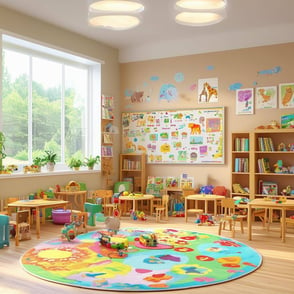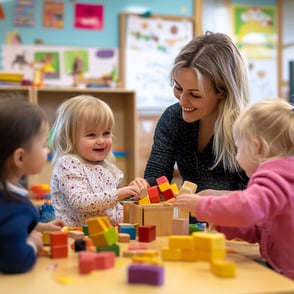Exploring the Reggio Emilia Approach: A Journey into Early Years Education
In the realm of early childhood education, few methodologies stand out quite like the Reggio Emilia approach. Originating in post-World War II Italy, this educational philosophy has garnered attention and admiration worldwide for its innovative and child-centric ways of fostering learning and development. This blog post delves into the specifics of the Reggio Emilia approach, including its developmental frameworks, pedagogic principles, and origins. We'll also explore some of the best-known schools in the UK that have embraced this model and compare it with other renowned early years specialisms such as Rudolf Steiner, Te Whāriki, HighScope, Forest School, and Montessori.
The Origin and History of the Reggio Emilia Approach
The Reggio Emilia approach was born in the small town of Reggio Emilia in northern Italy, in the aftermath of World War II. It was founded by Loris Malaguzzi, a visionary educator and psychologist, in collaboration with parents from the community who were determined to create a better future for their children. They sought to develop an educational system that emphasised respect, responsibility, and community involvement. He, like us, believed in the importance of structured play.
The essence of the Reggio Emilia method is rooted in the belief that children are capable, curious, and driven by their own interests (see our blog on how to foster creativity in young children here). This philosophy emphasises the importance of a supportive and enriching environment, where children can express themselves, engage in critical thinking, and pursue their natural curiosity. It is a holistic approach that values the child as an active participant in their own learning journey.
Core Areas of Learning and Developmental Frameworks
The Reggio Emilia approach is not defined by a set curriculum but is guided by a flexible framework that adapts to the needs and interests of the children. Here are some core areas of learning and development emphasised in this approach:
- Expressive Arts and Creativity: Reggio Emilia places a strong emphasis on the arts as a means of expression. Children are encouraged to explore various artistic mediums, allowing them to communicate their thoughts and emotions effectively.
- Social and Emotional Development: The approach prioritizes the development of social skills and emotional intelligence. Children are taught to navigate relationships, understand their emotions, and empathize with others.
- Cognitive Development and Critical Thinking: Through project-based learning and exploration, children develop their cognitive abilities and critical thinking skills. They are encouraged to question, hypothesize, and seek answers.
- Physical Development: While the focus is often on cognitive and emotional growth, physical development is also supported through activities that promote motor skills and coordination.
- Language and Communication: Language development is facilitated through conversations, storytelling, and collaborative projects, enhancing communication skills and vocabulary.
Principle Pedagogic Principles
Central to the Reggio Emilia approach are several key pedagogic principles that guide the teaching and learning process:
- The Image of the Child: Children are viewed as competent, capable, and full of potential. Educators recognize the importance of listening to children's ideas and valuing their contributions.
- The Role of the Environment: Often referred to as the "third teacher," the environment plays a crucial role in the Reggio Emilia approach. Classrooms are designed to be inviting, flexible, and rich in resources, encouraging exploration and discovery.
- Collaboration and Relationships: Education is seen as a collaborative endeavor involving children, educators, and parents. Building strong relationships within the learning community is paramount.
- Documentation and Reflection: Educators meticulously document children's learning experiences, using various tools such as photos, videos, and written records. This documentation serves as a basis for reflection and planning.
- Emergent Curriculum: The curriculum is not predetermined but emerges from the interests and inquiries of the children. This dynamic approach allows for a responsive and individualized learning experience.
Reggio Emilia in the UK: Notable Schools
In recent years, the Reggio Emilia approach has gained popularity in the UK, with several schools adopting its principles. Some of the best-known schools include:
- The Acorn School: Located in Gloucestershire, The Acorn School embraces the Reggio Emilia philosophy, offering a nurturing and creative environment for children aged 3 to 11.
- St. Mark's Primary School: Situated in Bath, this school integrates Reggio Emilia principles into its early years curriculum, focusing on child-led learning and exploration.
- Dame Catherine Harpur's School: In Derbyshire, this independent school incorporates the Reggio Emilia approach, emphasising creativity, community, and the development of the whole child.
Comparing Reggio Emilia with Other Early Years Specialisms
When exploring early childhood education, it's important to consider other philosophies that share a commitment to fostering individual growth and potential. Let's compare Reggio Emilia with some other renowned approaches:
Rudolf Steiner (Waldorf Education)
Waldorf education, developed by Rudolf Steiner, shares the emphasis on creativity and holistic development with Reggio Emilia. Both approaches view children as active participants in their own learning. However, Waldorf education incorporates a structured curriculum with a strong focus on rhythm and routine, while Reggio Emilia is more flexible and emergent. For more information on the Steiner approach, read our blog here
Te Whāriki
Originating in New Zealand, Te Whāriki is a bicultural curriculum framework that emphasizes the importance of family and cultural context in learning. Like Reggio Emilia, it values community involvement and the child's interests. However, Te Whāriki places a stronger emphasis on inclusivity and cultural relevance, particularly in a New Zealand context. For more information on Te Whariki, read our blog here
HighScope
HighScope is known for its active participatory approach, focusing on key experiences that promote learning. Both HighScope and Reggio Emilia emphasise active learning and the child's agency. HighScope, however, is more structured in its use of "plan-do-review" sequences, providing a more defined framework for activities. For more information on the High Scope Methodology, read our blog here
Forest School
Forest School is a nature-based approach that encourages outdoor learning and connection with the natural environment. While Reggio Emilia also values experiential learning, Forest School uniquely prioritises outdoor, hands-on experiences as the primary setting for education. Reggio Emilia classrooms, although creative, are more traditionally structured indoors. For more information on the Forest School methodology, read our blog here
Montessori
Montessori education, founded by Maria Montessori, shares a respect for the child's autonomy and self-directed learning with Reggio Emilia. Both approaches view the environment as crucial to learning. However, Montessori relies on specific materials and a prepared environment to guide learning, while Reggio Emilia encourages more open-ended exploration and creativity. For more information on the Montessori method, please read our blog here
Conclusion: Embracing Diversity in Early Years Education
The Reggio Emilia approach has undoubtedly made a significant impact on the field of early childhood education, offering a unique perspective on how children learn and grow. Its focus on creativity, collaboration, and the child's voice aligns with the values of many educators and parents seeking a more holistic and child-centered approach.
While each early years specialism has its strengths and unique characteristics, the diversity of methodologies enriches the landscape of early childhood education. By exploring and understanding these approaches, educators and parents can make informed choices that align with their educational philosophies and the needs of their children.
In the end, whether one chooses Reggio Emilia, Waldorf, Te Whāriki, HighScope, Forest School, or Montessori, the goal remains the same: to nurture, inspire, and empower young minds as they embark on their lifelong journey of learning and discovery.

31-Dec-2024 18:26:00
Related Articles





Write a Comment